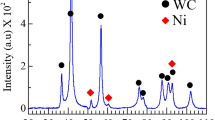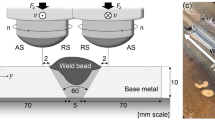Abstract
Welding matrix composites that have been formed with conventional methods produce many discontinuities which harm the quality of joints. Friction stir welding (FSW) offers an alternative method to prevent these issues. However, the existence of reinforcing particles, such as silicon carbide in metal matrix composites (MMCs), has significantly increased the wear rate of FSW tools and hence, reducing their tool life. Therefore, this research has focused on the improvement of FSW tool life in joining the aluminum matrix composites, through surface enhancement. H13 tool steel and tungsten carbide, as a base material, were used for the FSW tool, and graphene, carbon nanotubes, and diamond-like carbon were chosen for coating the FSW tool. Subsequently, the wear on the FSW tool was measured before and after welding to evaluate tool life. The result of wear measurement indicates that the wear resistance of the diamond-like carbon (DLC)–coated tungsten carbide was higher than the others. The tool life of the coated tungsten carbide (WC)-DLC was prolonged to approximately 41%. In addition, it is predicted that the FSW tool can be effective for up to 1200 mm of weld joint.



















Similar content being viewed by others
References
Thomas ENW, Needham J, Murch M, Temple-Smith P, and Dawes C, 1991
Meyghani B, Awang M, Emamian SS, Nor M, Khalid M, Pedapati SR (2017) A comparison of different finite element methods in the thermal analysis of friction stir welding (FSW). Metals 7(10):450
Emamian S, Awang M, Hussai P, Meyghani B, Zafar A (2006) Influences of tool pin profile on the friction stir welding of AA6061. ARPN Eng Appl Sci 11:12258–12261
Sulaiman S and Emamian S, " 2014 Optimum speed of friction stir welding on 304L stainless steel by finite element method
Sulaiman S, Emamian S, Sheikholeslam M, Mehrpouya M (2013) Review of the effects of friction stir welding speed on stainless steel type 304L. Int J Mater Mech Manuf 1(1):85–87
Clyne T, Withers P (1995) An introduction to metal matrix composites. Cambridge university press
Prater T (2014) Friction stir welding of metal matrix composites for use in aerospace structures. Acta Astronautica 93:366–373
"Friction Stir Welding." https://www.nasa.gov/centers/marshall/pdf/104835main_friction.pdf (accessed 2019
Prater TJ 2008 "An investigation into the friction stir welding of AL 6061 and AL 6061/SiC/17.5 p using diamond coatings"
Prater T, Strauss A, Cook G, Gibson B, Cox C (2013) A comparative evaluation of the wear resistance of various tool materials in friction stir welding of metal matrix composites. J Mater Eng Perform 22(6):1807–1813
Mishra RS, Ma Z (2005) Friction stir welding and processing. Mater Sci Eng R Rep 50(1–2):1–78
Emamian S et al. 2017 "A review of friction stir welding pin profile," Singapore: Springer Singapore, in 2nd International Conference on Mechanical, Manufacturing and Process Plant Engineering, pp. 1–18
Gibson BT et al (2014) Friction stir welding: process, automation, and control. J Manuf Process 16(1):56–73
Siddiquee AN, Pandey S (2014) Experimental investigation on deformation and wear of WC tool during friction stir welding (FSW) of stainless steel. Int J Adv Manuf Technol 73(1–4):479–486
Tiwari A, Pankaj P, Biswas P, Kore S, Rao AG (2019) Tool performance evaluation of friction stir welded shipbuilding grade DH36 steel butt joints. Int J Adv Manuf Technol:1–17
Çam G (2011) Friction stir welded structural materials: beyond Al-alloys. Int Mater Rev 56(1):1–48
Rai R, De A, Bhadeshia HKDH, Debroy T (2011) Review: friction stir welding tools. Sci Technol Weld Join 16. https://doi.org/10.1179/1362171811Y.0000000023
Prado R, Murr L, Soto K, McClure J (2003) Self-optimization in tool wear for friction-stir welding of Al 6061+ 20% Al2O3 MMC. Mater Sci Eng A 349(1–2):156–165
Fernandez G, Murr LE (2004) Characterization of tool wear and weld optimization in the friction-stir welding of cast aluminum 359+ 20% SiC metal-matrix composite. Mater Charact 52(1):65–75
Shindo D, Rivera A, Murr L (2002) Shape optimization for tool wear in the friction-stir welding of cast AI359-20% SiC MMC. J Mater Sci 37(23):4999–5005
Lee C-Y, Choi D-H, Yeon Y-M, Jung S-B (2009) Dissimilar friction stir spot welding of low carbon steel and Al–Mg alloy by formation of IMCs. Sci Technol Weld Join 14(3):216–220
Dressler U, Biallas G, Mercado UA (2009) Friction stir welding of titanium alloy TiAl6V4 to aluminium alloy AA2024-T3. Mater Sci Eng A 526(1–2):113–117
Miles M, Feng Z, Kohkonen K, Weickum B, Steel R, Lev L (2010) Spot joining of AA 5754 and high strength steel sheets by consumable bit. Sci Technol Weld Join 15(4):325–330
Chen Y, Nakata K (2009) Microstructural characterization and mechanical properties in friction stir welding of aluminum and titanium dissimilar alloys. Mater Des 30(3):469–474
Emamian S et al (2017) Comparison of carbon-based nanomaterials characteristics on H13 tool steel: Vergleich der Eigenschaften Kohlenstoff-basierter Nanomaterialien auf H13 Werkzeugstahl. Mater Werkst 48(3–4):198–204
Takai H, Ezumi M, Aota K, Matsunaga T (2007) Basic study of friction stir welding tool life-investigation for increase of FSW reliability. Weld Int 21(9):621–625
DebRoy T, De A, Bhadeshia H, Manvatkar V, Arora A (2012) Tool durability maps for friction stir welding of an aluminium alloy. Proc Royal Soc A Math Phys Eng Sci 468(2147):3552–3570
Meilinger Á, Török I (2013) The importance of friction stir welding tool. Prod Process Syst 6(1):25–34
Mahoney MW and Mishra RS 2007 Friction stir welding and processing. ASM International
Sergici AO, Randall NX (2006) Scratch testing of coatings. Adv Mater Process 164(4):41–43
Prater TJ 2012 Predictive process modeling of tool wear in friction stir welding of metal matrix composites. Vanderbilt University
Funding
This work was supported by Universiti Teknologi PETRONAS and Universiti Malaya.
Author information
Authors and Affiliations
Corresponding author
Additional information
Publisher’s note
Springer Nature remains neutral with regard to jurisdictional claims in published maps and institutional affiliations.
Rights and permissions
About this article
Cite this article
Emamian, S.S., Awang, M., Yusof, F. et al. Improving the friction stir welding tool life for joining the metal matrix composites. Int J Adv Manuf Technol 106, 3217–3227 (2020). https://doi.org/10.1007/s00170-019-04837-1
Received:
Accepted:
Published:
Issue Date:
DOI: https://doi.org/10.1007/s00170-019-04837-1




